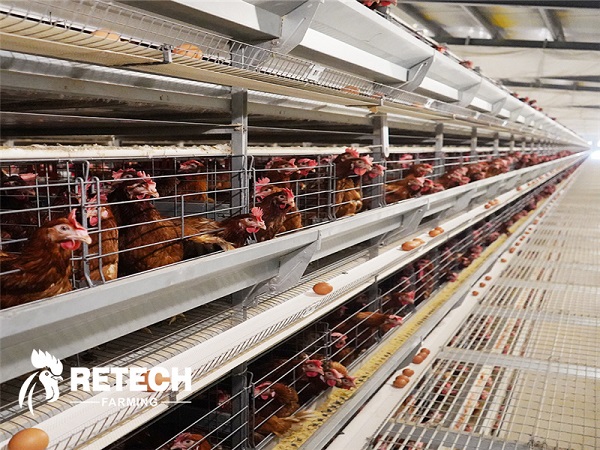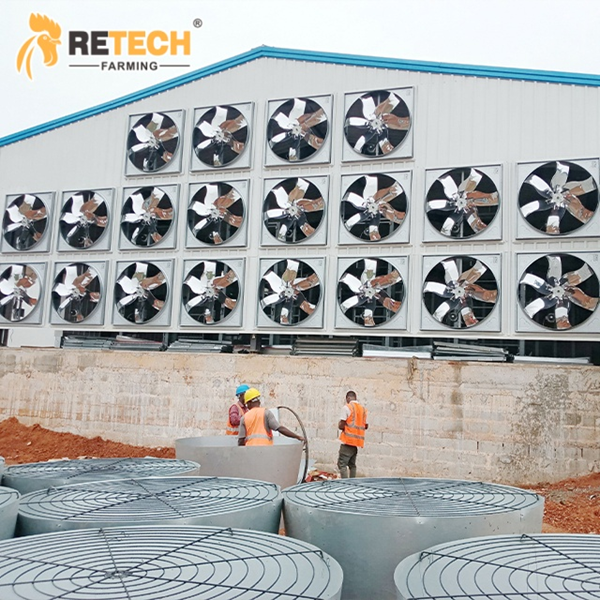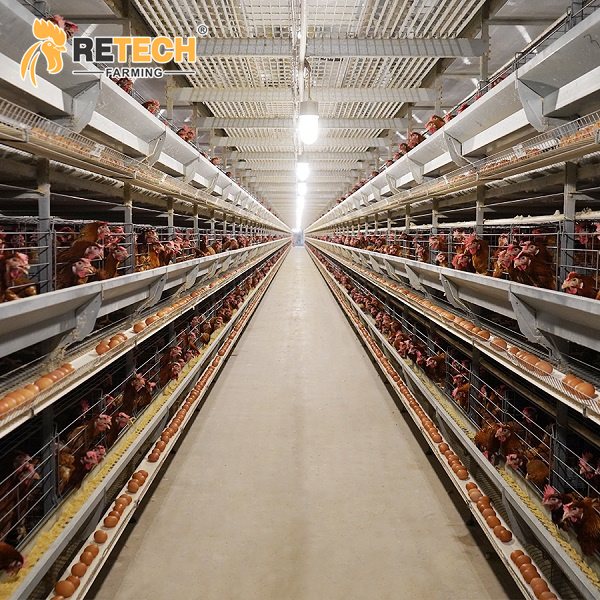How can I start raising chickens in tropical countries due to the high temperatures?
Retech Farming has rich experience in the production and installation of poultry farming equipment. We have completed client projects in Nigeria, Kenya, Tanzania, the Philippines, and Indonesia. We understand your local climate and can customize local service solutions. To address the impact of high temperature and humidity on poultry farming, contact us now for poultry farming solutions!
How do you keep chickens cool during the summer heat?
Environmental control system within the chicken house, including temperature and ventilation, is a major concern. Chicken farms must have a generator to prevent unexpected power outages, which have occurred frequently. The lack of an emergency power source in the chicken house has led to heatstroke deaths.
What problems might chickens encounter in high temperatures?
1.Main Challenges for Layers in Summer
Decreased Egg Production: High temperatures reduce feed intake, leading to insufficient nutrient intake and a significant decrease in egg production rate and egg weight.
Decreased Eggshell Quality: Increased respiratory rate causes respiratory alkalosis, which in turn affects calcium carbonate deposition in the eggshell, resulting in soft and thin-shelled eggs.
Intestinal Health Issues: Heat stress weakens the intestinal mucosal barrier function, resulting in intestinal inflammation, hemorrhagic spots, watery stools, and overfeeding.
Oxidative Stress: High temperatures stimulate an increase in free radicals in chickens, weakening their immunity and increasing the risk of mortality.
What problems might arise on a farm during high temperatures?
1. Power system overload and water shortage
2. Ventilation system obstruction (blocked wet curtains, reduced fan efficiency, etc.)
3. Water source hygiene
4. Pest and rodent infestation
How to keep chickens cool on hot summer days?
1. Environmental Control (Cooling the House)
♦Wet curtain cooling
Ensure the fan is fully operational before opening the wet curtains. Maintain a temperature differential of 1.5-2°C to prevent premature opening of the wet curtains and excessive humidity in the house. Large exhaust fans are installed on the side of the house to exhaust hot air, keeping the house cooler.
♦Roof sprinkler and mist line system
Use roof sprinklers and indoor misting systems to lower the house temperature, but pay attention to humidity control to avoid water vesicles and respiratory problems.
♦Enhance the airtightness of the house
Regularly check the sealing of small windows to ensure effective vertical ventilation.
♦Increase air speed
Use cooling ducts, fan maintenance, and wind deflectors to increase air speed to enhance the cooling effect felt by the birds. Repair old fans, update fans, add wind ducts: increase the number of fans
♦Ensure stable water supply
- Sudden water outages and low water pressure—use backup water tanks/storage tanks, and rent water trucks in critical situations.
- Control water outages for drinking water immunization.
- Frequently check the dosing system, as it may also experience anomalies.
- Inspect water supply and waterline hygiene.
♦Ensure normal power supply
- Regularly test and inspect generators.
- Promptly maintain and repair automation equipment.
- Measure rodent control.
- Inspect wiring.
2. Adjustments to animal husbandry management
♦Increase feeding frequency and midnight supplemental feeding: Avoid high-temperature periods and increase feeding frequency to increase feed intake.
♦Prevent mold and nutrient loss: Reduce feed stockpiling and apply sunscreen to feed silos to reduce the risk of mold.
♦Promptly remove manure: Avoid high temperatures, which can cause heat generation from manure fermentation, increase ammonia, and promote fly breeding.
2.1 Water Line
- Water temperature control: Avoid direct sunlight on water towers and install a sunshade.
- Sanitation: Surface water should be pre-treated before entering the chicken house.
- Water line cleaning: Maintain a regular backflushing and soaking schedule to reduce pathogen loads in the water line.
2.2 Feed Line
- Reduce nutrient loss from high temperatures: Minimize feed stockpiling and apply sunscreen to feed towers.
- Leftover Feed Management: Minimize leftover feed in feed troughs before lights out to prevent mold.
- No feeding during the hottest part of the day.
- Midnight Feeding: Decision based on feed intake, egg weight, body weight, etc.
- Increase daily feeding frequency, preferably during cooler temperatures.
FAQ
1.How to adjust nutrition if there is a problem with eggshell quality?
A: When thinning eggshells and an increase in soft eggs are observed, supplement nutrition through the water line immediately. Combined with adjustments to environmental control equipment, a multi-pronged approach should be implemented to quickly restore the chickens’ health.
2.How to address reduced feed intake and increased watery feces in summer?
A: Watery feces can be significantly reduced by strengthening environmental control measures, lowering the perceived temperature of the birds, and appropriately increasing electrolyte supplementation.
3.How should I adjust my nutrition if I’m experiencing eggshell quality issues?
A: Pay attention to the calcium-phosphorus ratio in your feed. Use high-potency vitamins and trace elements (especially zinc and selenium) to strengthen eggshells and reduce breakage.
Post time: Jul-29-2025










